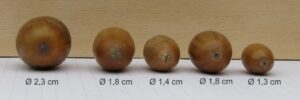Killed by an acorn!
In October the DWHC investigated the death of a roe deer fawn found in the Kromme Rijn area in the province of Utrecht. The fawn was thin and the tail and hind legs were soiled. Upon necropsy the cause of death was immediately apparent: a large acorn measuring 3,4 x 2,3 cm was found in the throat, blocking the windpipe and presumed to have resulted in the fawn choking. As there was no evidence of an inflammatory reaction in the surrounding tissues it is believed that death occurred very rapidly. For this reason the presence of the acorn cannot explain the poor body condition of this animal.
|
On the far left, the acorn found blocking the windpipe of this deer; four normal-sized acorns for comparison |
 |
No evidence of tularemia
Tularemia, caused by the bacteria Francisella tularensis, was found to be the cause of death in a dead hare found on the same evening close to the deer cadaver. Although tularemia is occasionally reported in species other than the hare, including in roe deer, it is not well understood whether these animals become ill or simply act as carriers of the disease. This fawn tested negative for the presence of this bacteria.





